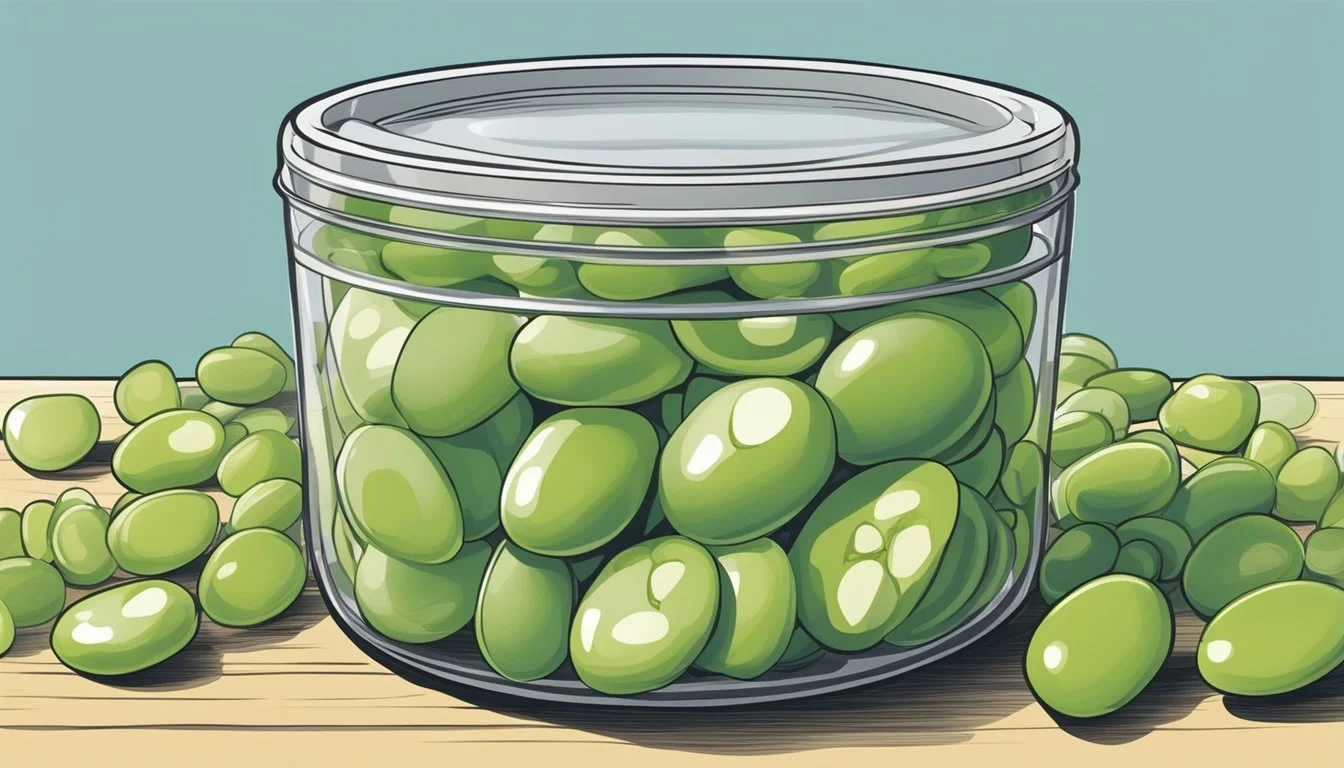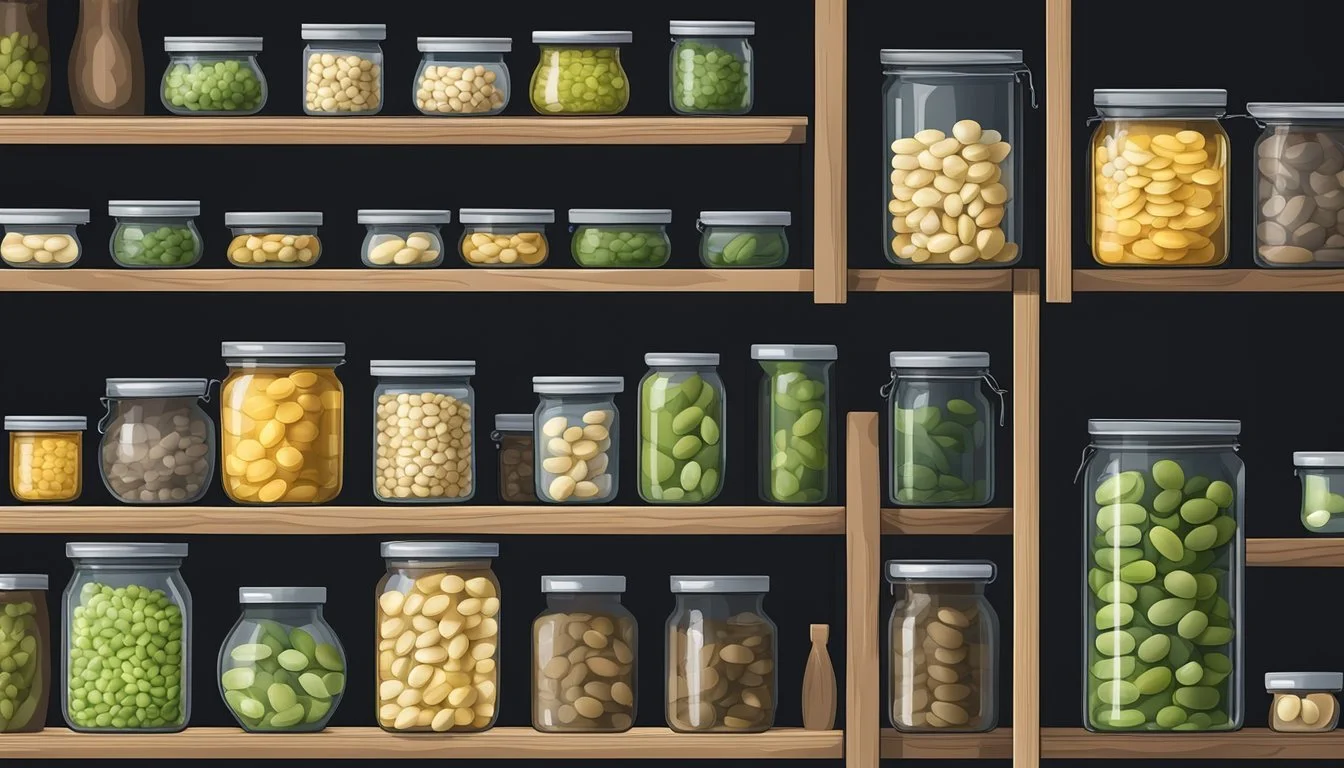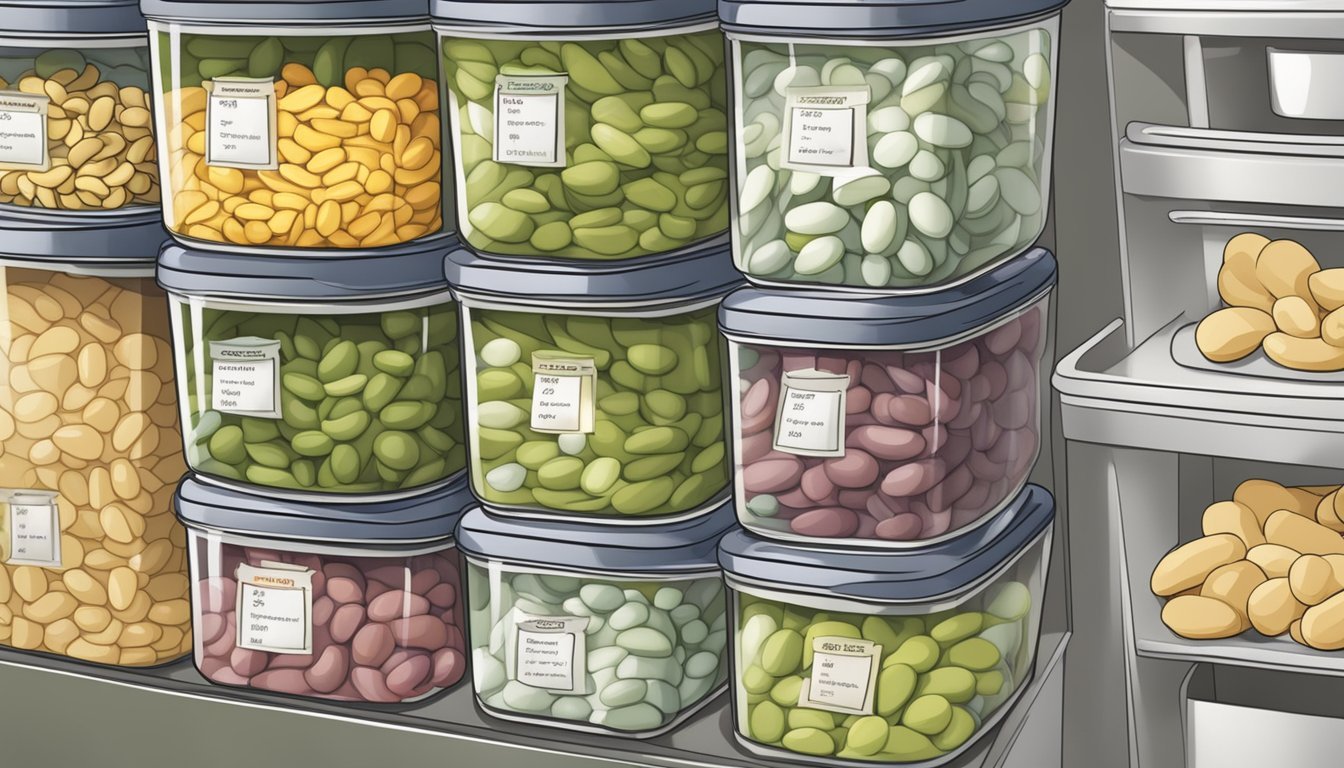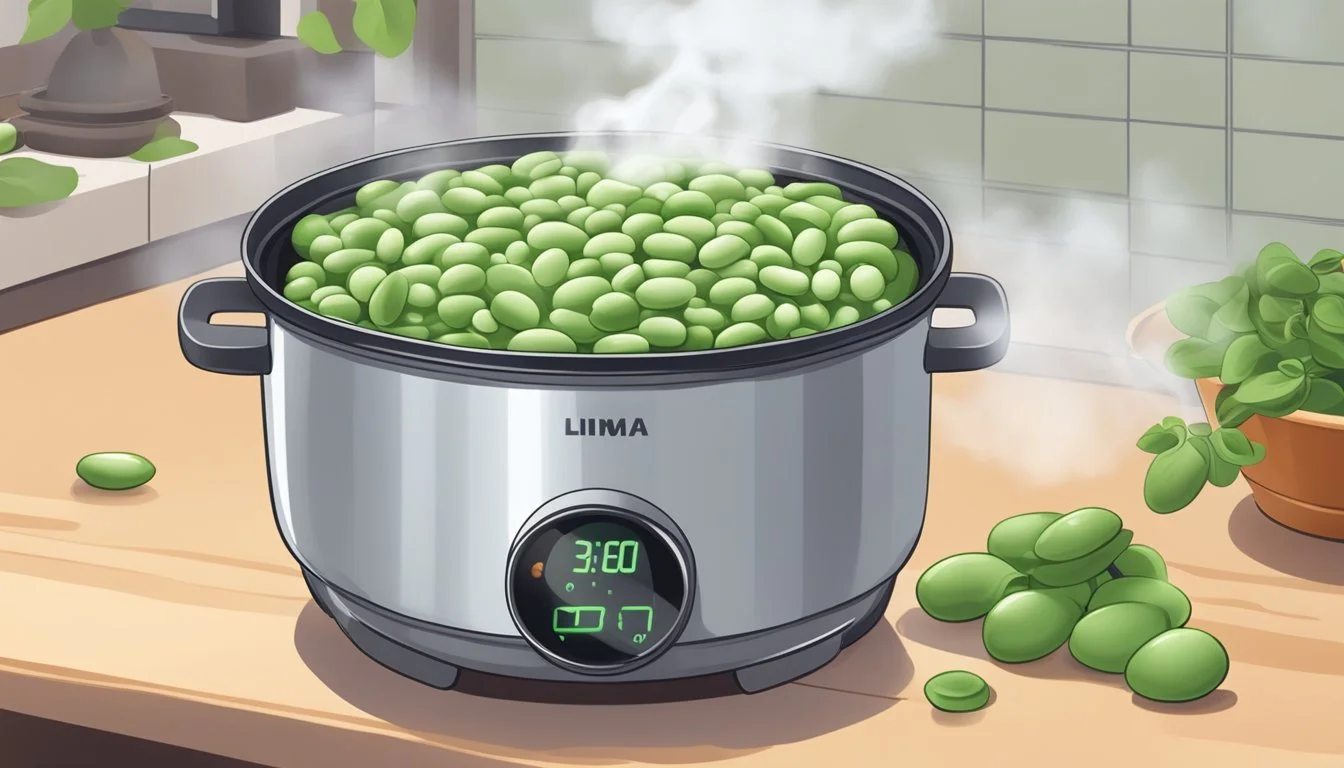How Long Do Lima Beans Last?
Shelf Life and Storage Tips
Lima beans, a nutritious legume also known as butter beans, have a distinctive place in both culinary tradition and healthy diets. Recognized for their creamy texture and subtle flavor, they play a pivotal role in various dishes, from Southern classics to international cuisine. When it comes to their shelf life, dried lima beans have an impressive longevity, retaining their quality for an extended period if stored under optimal conditions.
Uncooked dried lima beans can last one to two years when kept in a cool, dry place in an airtight container, ensuring they are shielded from moisture and pests. Beyond this timeframe, while the beans may remain safe to eat, their quality and nutritional value may begin to decline. It is worth noting that the preservation of lima beans hinges on proper storage and handling procedures.
Once cooked, lima beans need careful attention to remain safe for consumption. Refrigerated within two hours of cooking, they should be consumed within three to five days to guarantee freshness and prevent the growth of bacteria. Ensuring that lima beans are stored correctly at every stage, from the pantry to the plate, is essential for maintaining their quality and maximizing their nutritional benefits.
Identifying Freshness and Quality of Lima Beans
When selecting lima beans, one must consider key indicators, such as visual cues, smell, and texture, to ensure they are fresh and of good quality.
Visual Indicators of Quality and Spoilage
High-quality lima beans exhibit a vibrant green color and a firm surface free from blemishes. Fresh lima beans should appear plump and taut, indicating they've been recently harvested. Signs of spoilage include:
Discoloration: Yellowing or darkened beans often indicate age or improper storage.
Shriveling: A sign beans have begun to lose their inherent moisture.
Spots: Dark spots may suggest the onset of mold or decay.
Smell and Texture as Indicators
Lima beans should have a subtle, earthy aroma. A fresh bean feels firm to the touch without being hard. Spoiled beans emit an off smell; it can be described as sour or musty. Spoilage is also evident when beans feel slimy or overly soft, a clear deviation from their natural state.
Best Practices for Ensuring Bean Quality
To ensure the quality of lima beans, one should:
Store fresh lima beans in the vegetable drawer of the refrigerator.
For dried lima beans, keep them in an airtight container in a cool, dry place to maintain flavor and texture.
Regularly check stored beans, looking for changes in color, smell, or texture that indicate they are past their prime.
Storing Lima Beans for Optimal Shelf Life
Proper storage of lima beans significantly extends their shelf life and maintains best quality. Whether dealing with fresh or dried lima beans, one can use several effective methods to preserve their nutritional value and flavor.
Short-Term Storage Solutions
For short-term storage, lima beans should be kept in conditions that are cool and away from light. Dried lima beans last well in a pantry or a kitchen cupboard, while fresh lima beans need to be refrigerated.
Dried Lima Beans: Store in a cool, dry place inside airtight containers to protect them from moisture and pests. The ideal temperature is typically around 50-70°F (10-21°C).
Fresh Lima Beans: Refrigerate in a vegetable crisper where the temperature should be maintained between 32-40°F (0-4°C). For best quality, place them in perforated plastic bags for airflow, and use within one week.
Long-Term Freezing Methods
Freezing is ideal for extending the shelf life of lima beans for several months. Before freezing, one should ensure the beans are prepped correctly to maintain their quality.
Dried Lima Beans: Should be cooked before freezing. After cooking, let them cool and then portion into freezer bags or airtight containers. Squeeze out excess air and freeze where they can last up to six months.
Fresh Lima Beans: Blanching is necessary before freezing to preserve their texture and color. Blanch, cool, and dry the beans, then transfer to freezer bags, label with the date, and freeze. Properly frozen, they can last up to eight months in the freezer.
Remember not to thaw and refreeze lima beans as this can compromise their texture and flavor. When ready to use, cook directly from frozen or thaw in the refrigerator overnight.
Maximizing Lima Bean Longevity
Proper storage techniques can significantly extend the longevity of lima beans, whether cooked, dried, or fresh. By controlling environmental factors such as temperature and moisture, one can maintain the quality and safety of these beans.
The Role of Temperature and Environment
Temperature plays a critical role in preserving lima beans. Cooked lima beans should be stored in the refrigerator at temperatures below 40°F (4°C) and are safe to consume for 3 to 5 days when kept in shallow airtight containers or resealable plastic bags. To prevent the growth of bacteria, they must be refrigerated within two hours of cooking.
For dried lima beans, a cool, dry place such as a pantry is ideal. They should be stored at room temperature away from direct sunlight and heat sources. High temperatures can shorten their shelf life and reduce their quality. Properly stored dried beans have a minimum shelf life of one year but can last indefinitely if the environmental conditions are optimal.
Moisture Control and Dry Storage Parameters
Moisture is the enemy of dried lima beans. They must be kept in an environment where humidity is controlled to prevent them from becoming moldy or stale. Below are parameters for moisture control:
Pantry Storage:
Store in airtight containers or tightly sealed plastic bags.
Keep them off the floor to protect against dampness.
Moisture Prevention:
Use desiccants (like silica gel packets) if necessary in humid environments.
Check regularly for signs of moisture and use beans promptly if any is detected.
By following these guidelines, the shelf life and flavor of lima beans can be maximized, whether they are enjoyed as a nutritious component in meals or stored for long-term use.
Understanding and Preventing Bean Spoilage
When it comes to preserving lima beans, recognizing signs of spoilage and implementing safety measures are crucial to prevent foodborne illnesses and ensure beans remain safe to consume.
Common Signs of Lima Bean Deterioration
Lima beans, both dried and fresh, are susceptible to spoilage. Indicators of deterioration may include:
Mold Growth: Visible mold or a musty smell are strong indicators that lima beans should be discarded.
Color Changes: Any significant change in color can be a sign that the beans are no longer good.
Texture: If the beans feel slimy or have a noticeable textural change, they are likely spoiled.
Regular inspection is key to detect these signs early and prevent the consumption of spoiled lima beans.
Foodborne Illness Risks and Safety Measures
Consumption of spoiled lima beans can lead to foodborne illness. To minimize risks, one must adhere to the following safety measures:
Correct Food Storage: Store dry lima beans in a cool, dry place in an airtight container. For fresh lima beans, keep them in the refrigerator set between 32-40°F (0-4°C).
Safety Date: While the expiration date on packaging can often be a conservative estimate, it should not be ignored. If beans are past this date, extra scrutiny should be applied before consumption.
Discard Unsafe Beans: If there is any uncertainty about the safety of the beans, err on the side of caution and discard them to prevent any risks associated with foodborne illness.
It is important to remember that a proactive approach to monitoring and storing lima beans is essential in maintaining their quality and safety.
Cooking and Usage Tips for Lima Beans
Lima beans require proper preparation and cooking methods to ensure their best usage in a variety of dishes. Whether one is looking to incorporate them into soups or to use them as a hearty salad ingredient, these beans offer versatility and nutritional value.
Preparing Lima Beans for Cooking
To begin, one should always rinse the lima beans thoroughly to remove any dirt or impurities. For dried beans, soaking overnight in water can reduce the cooking time and make them easier to digest. Some recipes recommend adding a pinch of salt to the soaking water to help the beans maintain their structure during cooking.
After soaking, drain and rinse the beans before cooking. Place them in a pot and cover with fresh water. They should be brought to a boil and then simmered over low heat. Cooking times may vary; dried lima beans generally take between 60 to 90 minutes to become tender.
Incorporating Lima Beans into Diverse Dishes
Lima beans are incredibly versatile and can be a staple ingredient in many recipes:
Soups and stews: Lima beans can be added to soups and stews for added heartiness and nutrition. They absorb the flavors of the broth and other ingredients, enriching the overall taste of the dish.
Salads: For a protein-rich addition to salads, cooked and cooled lima beans can be tossed in. They pair well with vinaigrette dressings and robust greens like kale.
Spreads and dips: One can blend lima beans into a smooth paste to create spreads or dips. Season with herbs and spices for a flavorful appetizer.
Additionally, lima beans can be preserved through canning, allowing them to be ready-to-use in recipes year-round. Remember to follow all safety guidelines when canning to ensure the beans are stored properly.
Nutritional Profile and Health Benefits
Lima beans are acknowledged for their high nutritional value, offering a wealth of fiber and protein, and serving as an excellent source of various vitamins and minerals essential for maintaining good health.
Lima Beans as a Source of Dietary Fiber and Protein
Lima beans, a legume also known as butter beans, are a rich source of dietary fiber. Fiber plays a critical role in digestive health by facilitating bowel regularity and may help in managing blood sugar levels, making lima beans beneficial for individuals with diabetes. The legume is also a source of plant-based protein, which is vital for muscle repair and growth. Here are some key nutritional facts about lima beans:
Dietary Fiber: One cup of cooked lima beans provides about 9 grams of fiber, which is approximately 36% of the recommended daily intake.
Protein: The same serving size offers about 15 grams of protein, constituting a significant portion of the recommended daily value for an adult.
Vitamins, Minerals, and Plant-Based Proteins
The nutritional benefits of lima beans extend beyond fiber and protein. These beans contain important vitamins such as B-vitamins, which assist in energy production and red blood cell formation. Lima beans are also a good source of minerals like iron, necessary for transporting oxygen in the blood, and potassium, which is essential for heart health and proper muscle function. Additionally, the combination of low sugar content and multiple nutrients underscores their role in a healthy diet. Key nutritional highlights include:
Iron: Essential for healthy blood cells and energy.
Potassium: Helps regulate fluid balance and supports heart health.
B-vitamins: Vital for energy metabolism in the body.
By incorporating lima beans into their diet, individuals gain access to a nutrient-dense food that supports overall health and well-being.
Practical Guidelines for Canned Lima Beans
Canned lima beans offer a convenient source of protein and nutrients, with a long shelf life when stored properly. Understanding the best storage methods and signs of quality can ensure these beans remain safe and palatable for consumption.
Optimal Conditions for Canned Bean Storage
For unopened canned lima beans, the key to maintaining their peak quality is to store them in a cool, dry area. Exposure to excessive heat or moisture can compromise the integrity of the can and its contents. The ideal storage condition is a pantry or a cupboard away from any heat sources, such as ovens or sunlight, which can accelerate degradation. A consistent temperature that is below room temperature is optimal.
Table of Ideal Storage Conditions:
Storage Location Temperature Conditions Pantry Below 85°F Cool, Dry Cupboard Below 85°F Away from heat sources and moisture
Under such conditions, unopened canned lima beans can last between 3 to 5 years, aiming to consume them by the "best by," "best if used by," "best before," or "best when used by" date for assurance of quality.
Assessing Canned Bean Quality Pre- and Post-Opening
Before opening, one should inspect the can for any signs of damage such as dents, rust, or swelling, which are potential indicators of compromised quality. If the can is intact, the contents are likely safe to consume up until the expiration date.
Once opened, the beans should be transferred to an airtight container if not used entirely at once. Opened canned lima beans should be refrigerated and it is recommended they be consumed within 3-4 days to ensure safety and quality. If a longer storage period is necessary, the beans can be frozen in a covered airtight container or freezer bag for 1-2 months.
Checklist for Post-Opening Storage:
Transfer to airtight container.
Refrigerate at temperatures below 40°F.
Consume within 3-4 days from opening.
Freeze if extending shelf life for up to 2 months.
Canned lima beans typically contain preservatives and additives to prolong shelf life. However, these compounds do not substitute proper storage methods. Adhering to these guidelines will help maintain both safety and taste of the product.
Techniques for Properly Freezing Lima Beans
Freezing lima beans effectively preserves their texture and nutritional value. This section provides readers with clear, step-by-step instructions on how to prepare and utilize frozen lima beans.
Freezing Preparation for Lima Beans
The key to maintaining optimum quality when freezing fresh lima beans, also known as butter beans, is to blanch them beforehand. Blanching involves scalding the beans in boiling water for a specific amount of time and then rapidly cooling them in cold water. This process helps in preserving the beans’ texture, color, and nutritional content.
Wash: Ensure the lima beans are thoroughly clean.
Blanch: Submerge small lima beans in boiling water for 2 minutes, medium beans for 3 minutes, and large beans for 4 minutes.
Cool: Immediately immerse the blanched beans in a large bowl of ice water.
Dry: Once cooled, drain and pat the beans dry.
Pack: Place the lima beans in freezer bags, remove excess air, and seal.
Label: Clearly label the bags with the date of freezing.
Store the prepared lima beans at 0 degrees Fahrenheit (-18 degrees Celsius) to ensure they last for up to six months without significant quality loss.
Thawing and Utilizing Frozen Lima Beans
Proper thawing is critical to ensure frozen lima beans maintain their quality when ready to be used in cooking.
Refrigerator Thawing: Transfer the needed amount of lima beans from the freezer to the refrigerator. Allow them to thaw slowly, often overnight.
Cold Water Thawing: Place the freezer bag of lima beans in a bowl of cold water to expedite thawing.
Microwave Thawing: Use the defrost function or set the microwave to 50% power. Use a microwave-safe container and check the beans frequently to prevent them from cooking.
Once thawed, beans should not be refrozen as this can affect their texture and taste. Thawed lima beans can be used in various recipes just like fresh ones, adding a nutritious dimension to any meal.
Factors Affecting Dried Lima Bean Shelf Life
Dried lima beans are a staple legume that, when stored properly, can remain a viable ingredient for extended periods. This section outlines the importance of optimal storage conditions and preparation methods to maximize their shelf life.
Storing Dried Beans in the Right Conditions
Proper storage is critical to maintaining the longevity and quality of dried lima beans. They should be kept in airtight containers to protect them from moisture and pests. The location for these containers should be a cool, dry place such as a pantry or cupboard away from direct sunlight, heat sources, and high humidity. Ensuring dryness in the storage environment prevents the beans from becoming moldy or stale.
Container: Airtight
Location: Cool, dry place (e.g., pantry)
Avoid: Moisture, pests, direct sunlight
Prepping Dried Beans for Use in Recipes
Before incorporating dried lima beans into recipes, proper preparation is necessary to ensure both their culinary quality and the reduction of cooking time. Soaking the beans overnight can help to soften them, leading to a more uniform cooking process. It is essential to discard the soaking water and rinse the beans to reduce any natural substances that may cause indigestion.
Soaking: Overnight (discard water afterward)
Rinsing: Required before cooking
Importance of Proper Food Storage Information
Accurate food storage information is essential to ensure that lima beans retain their quality and do not become a health hazard due to spoilage.
Guidelines for Lima Bean Storage
Temperature: Lima beans should be stored at a temperature between 32-40°F (0-4°C) to maintain their shelf life. Humidity: A relative humidity level of around 60% is ideal to keep beans moist without risking mold growth.
Refrigeration: For fresh lima beans, refrigeration is recommended to preserve their quality.
Dry Storage: Dried lima beans must be kept in a cool, dry place in an airtight container.
Recognizing Food Storage Warning Signs
Signs that lima beans have spoiled include:
Off Odor: An unusual smell is a clear indicator that lima beans may have gone bad.
Mold Growth: Visible signs of mold or fungus on the beans themselves or in their storage container.
Appearance: Any noticeable changes in color or texture can also suggest spoilage.
Exploring Creative Uses for Lima Beans
Lima beans offer versatility and a mild flavor that make them excellent for a range of dishes. Their ability to absorb flavors and add texture to meals allows them to be a staple in innovative recipes.
Lima Beans in Breakfast Dishes
In the morning, a nutritious start is essential. Lima beans can be seamlessly integrated into breakfast dishes to provide a protein-rich meal. They can contribute to a hearty Lima Bean Breakfast Hash, where they're sautéed with onions, bell peppers, and diced potatoes, offering a satisfying texture. Another inventive usage is in breakfast burritos or bowls, where cooked lima beans blend with eggs, cheese, and whole grains to kickstart the day with a balanced meal.
Contemporary Lima Bean Recipes for Any Meal
Lima beans' subtle taste makes them a perfect canvas for Modern Salads and Appetizers. Cooked lima beans can be tossed in a vibrant salad, mixed with fresh vegetables, and dressed with an acidic vinaigrette to balance the flavors.
For soups and stews, lima beans serve as a thickening agent while providing nutritional benefits. Zesty Lima Bean Stew is a dish where their creamy texture complements the bold spices and herbs.
One can also create a smooth Lima Bean Dip, blending the beans with garlic and olive oil for a spread that's both flavorful and full of fiber.
As a side or main course, contemporary recipes like Lima Bean and Herb Pilaf showcase the bean’s ability to mesh well with an array of herbs and acidic foods, offering a dish that is as elegant as it is nutritious.
Culinary Techniques for Cooking Lima Beans
In preparing lima beans, one should consider the cooking method that best suits their desired texture and flavor. The stove and microwave offer convenient methods, each affecting the beans' nutrients differently.
Methods for Cooking Lima Beans on the Stove
Sautéing with Aromatics: Begin by sautéing onions in olive oil until they are golden brown. Incorporate spices such as cumin, paprika, or chili powder to enhance the beans with a subtle kick.
Simmering: Place lima beans in a saucepan, covering them with water—typically 2 cups of water for every pound of beans. Add salt for taste, using about 1/2 teaspoon for each pound. Lima beans usually require about an hour to become tender.
Utilizing Lima Beans in Microwave Dishes
Rinsing: It’s crucial to rinse the beans to remove any impurities before cooking. Use a strainer and run cold water through the beans for 1-2 minutes.
Microwave Cooking: For quick cooking, combine lima beans with a bit of water in a microwave-safe dish. Cover with a lid or microwave-safe plastic wrap. Microwave on high for 10-15 minutes, checking for the desired tenderness.
Cooking lima beans properly can enhance both their flavor and nutrient content, offering a versatile addition to any recipe.
Conclusion
When storing dried lima beans, proper conditions can extend their shelf life considerably. In a cool, dry place, they can last a minimum of one year, but often much longer if undamaged and stored correctly.
For cooked lima beans, refrigerator storage is essential. They typically last 3-5 days when refrigerated promptly after cooking. It's crucial to refrigerate them within two hours of cooking to prevent bacterial growth.
In the freezer, cooked lima beans are safe to consume for a much longer period. They maintain their best quality for up to 6 months, although they remain edible beyond this time frame.
To summarize the storage times:
Dried Lima Beans: 1+ years in a cool, dry place
Cooked Lima Beans (Refrigerated): 3-5 days
Cooked Lima Beans (Frozen): Best quality for 6 months
It is important to ensure that beans are stored correctly to maximize their shelf life and maintain quality. Users should always check for signs of spoilage, such as off odors or discoloration, and discard any beans that do not meet safety standards.











